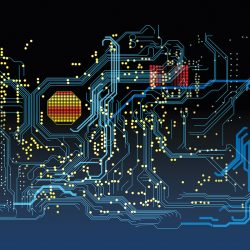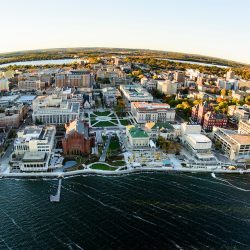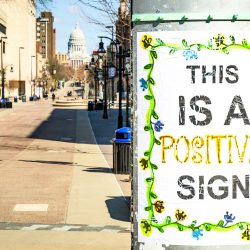Land of Possibilities
In a new UW lab, students create cool things for our interconnected world.

Tyler Waite, right, uses a pair of Oculus Rift virtual-reality glasses while Stephen Monette works on computing software as part of their group’s “Virtual World Builder” project. Photo: Jeff Miller.
Bluetooth on drones and brain-wave probes on helmets. Virtual-reality tours and food-tracking fridges. Bike racks that report theft with instant pings. These are a few of our students’ favorite things — at least at UW–Madison’s new Internet of Things Lab.
The “Internet of Things” [IoT] concept represents the convergence of technological advances in sensing, connectivity, cloud computing, and virtual interfaces, says Thomas Yen MS’91, PhD’97, the IoT Lab’s technical director. A growing network of interconnected devices capture, share, and access data in real time, creating endless possibilities and an environment in which “capability can come before need,” he says.
Each semester, around forty UW students are devoting their free time to finding — and solving — these needs in applications ranging from health care to retail. The IoT Lab, which opened in 2014, serves as a “technology sandbox,” says Alfonso Gutiérrez MS’94, a research director for the lab. While students don’t receive class credit, they do have a unique opportunity to “play” with the latest “toys” — things including virtual-reality headsets, radio-frequency identification tags, and armbands that record muscle movement.
So far, student teams have harnessed these technologies to begin developing a wristband that notifies users which medications to take and when; a kitchen system that allows users to check food in and out of refrigerators, which can then synthesize shopping lists, track food expiration, and create recipes; a football helmet that can better measure concussion symptoms and communicate with medical personnel; and more.
Teams presented their innovations to some four hundred students, faculty, and industry representatives at an open house last December. With increasing interest and project sophistication, the lab hopes to augment the students’ hands-on experiences by further aligning projects with faculty research and engaging local businesses.
In addition to solving real-world problems, students are refining real-world skills such as collaboration, Yen says. Business students, for instance, have helped engineering students with market research and revenue modeling.
“Part of the purpose of the lab is not only that [students] develop ideas,” Gutiérrez says, “but they learn how to work in groups, work with different disciplines, and work with different cultures.”
Published in the Summer 2015 issue



Comments
No comments posted yet.